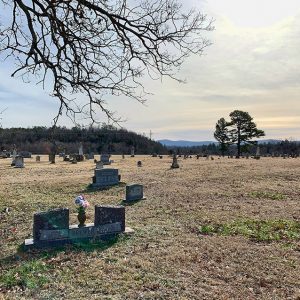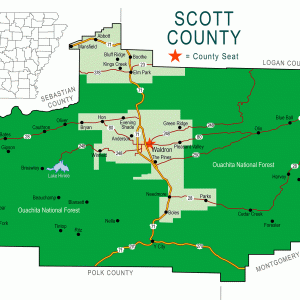calsfoundation@cals.org
Buffalo (Scott County)
Buffalo is a historical community in southern Scott County located along U.S. Highway 71. The community was established along Buffalo Creek. The agriculture and timber industries have contributed to the economy and way of life in Buffalo.
Prior to European exploration, the area surrounding Buffalo was a wilderness. Several species of wildlife that no longer inhabit the area, such as elk and buffalo, were present throughout the region. Numerous archaeological sites and burial mounds can be found along the banks of prominent waterways such as the Fourche La Fave River. Archaeological findings have provided evidence of early inhabitants dating to the Archaic, Woodland, and Mississippian periods. Further archaeological evidence has indicated that the people of the Caddo tribe later inhabited the area.
During the late seventeenth and early eighteenth centuries, French hunters and tradesmen traveled west from the Arkansas Post, exploring portions of western Arkansas. Several rivers that flow through Scott County were likely named by these French explorers, including the Petit Jean, Poteau, and Fourche La Fave. It is probable that the explorers traveled along the Fourche La Fave River near present-day Buffalo.
Settlers began arriving in the area now known as Buffalo during the late 1830s and early 1840s. The area was continually settled through the early twentieth century. Settlers participated in a wide variety of agricultural practices.
Men called to fight in the Civil War served with both the Confederacy and Union. The women, children, and elderly were left to look after family homes and farms. Instances of bushwhacking occurred in the area. During the war, lead was often scarce. Located east of Buffalo was the Buck Gaines lead mine, which was reportedly kept a secret from the Union army. According to legend, Gaines would ride to the mine on horseback with his father to acquire lead for the Confederates.
During Reconstruction, many people looking for a new life settled throughout portions of Scott County. Buffalo Cemetery was established in 1874 along Buffalo Creek. During the late nineteenth and early twentieth centuries, Buffalo Creek could be crossed via a swinging bridge located near the cemetery.
In May 1882, the Scott County Courthouse burned, destroying all records that defined the boundaries of the various school districts that had been established throughout the county. In August, the county court reestablished the boundaries of the fifty-six school districts active in the county, including Buffalo School District (Number 53). Reportedly, there were three locations of early schools in Buffalo. The first was located east of Highway 71 and south of Highway 28 on land belonging to the Lawrence family. Another school was located north of the Ray Lovett residence. The third school was across from Buffalo Cemetery near Buffalo Creek. The third schoolhouse was erected sometime in the 1870s and was a log building. A fourth school building was erected 200 yards north of the old log building. It was rectangular in shape and also served as a church. It burned down sometime in the early 1920s. A fifth school building was erected in its place. The fifth school building was square with a hipped roof. It also served as a place of worship on Sundays and as an election hall. The Buffalo School District was consolidated with the Boles (Scott County) district in 1930. After consolidation with Boles, the Buffalo school building was used as a dwelling. Later, the school building was moved to Waldron (Scott County) and converted into a dance hall. It later burned down. The only remains of the Buffalo school is an old well curb near where it once stood.
Hunting and fishing are popular recreational activities in Buffalo and the surrounding area. Agriculture continues to be a prominent way of life, mostly in the form of cattle and chicken farms. Portions of the Ouachita National Forest west of Buffalo are logged by various timber companies.
For additional information:
Cate, Michael. History of Scott County, Arkansas. Dallas, TX: Curtis Media Corporation, 1991.
Echoes: The Scott County Historical and Genealogical Society Quarterly. Waldron, AR: Scott County Historical and Genealogical Society (1986–).
Goodner, Charles. Scott County in Retrospect. Mansfield, AR: Frank Boyd, 1976.
Goodner, Norman. A History of Scott County, Arkansas. Siloam Springs, AR: Bar D Press, 1941.
McCutcheon, Henry Grady. History of Scott County, Arkansas. Little Rock: H. G. Pugh and Company, 1922.
Ty Richardson
Richardson Preservation Consulting
 Buffalo Cemetery
Buffalo Cemetery  Scott County Map
Scott County Map 



Comments
No comments on this entry yet.